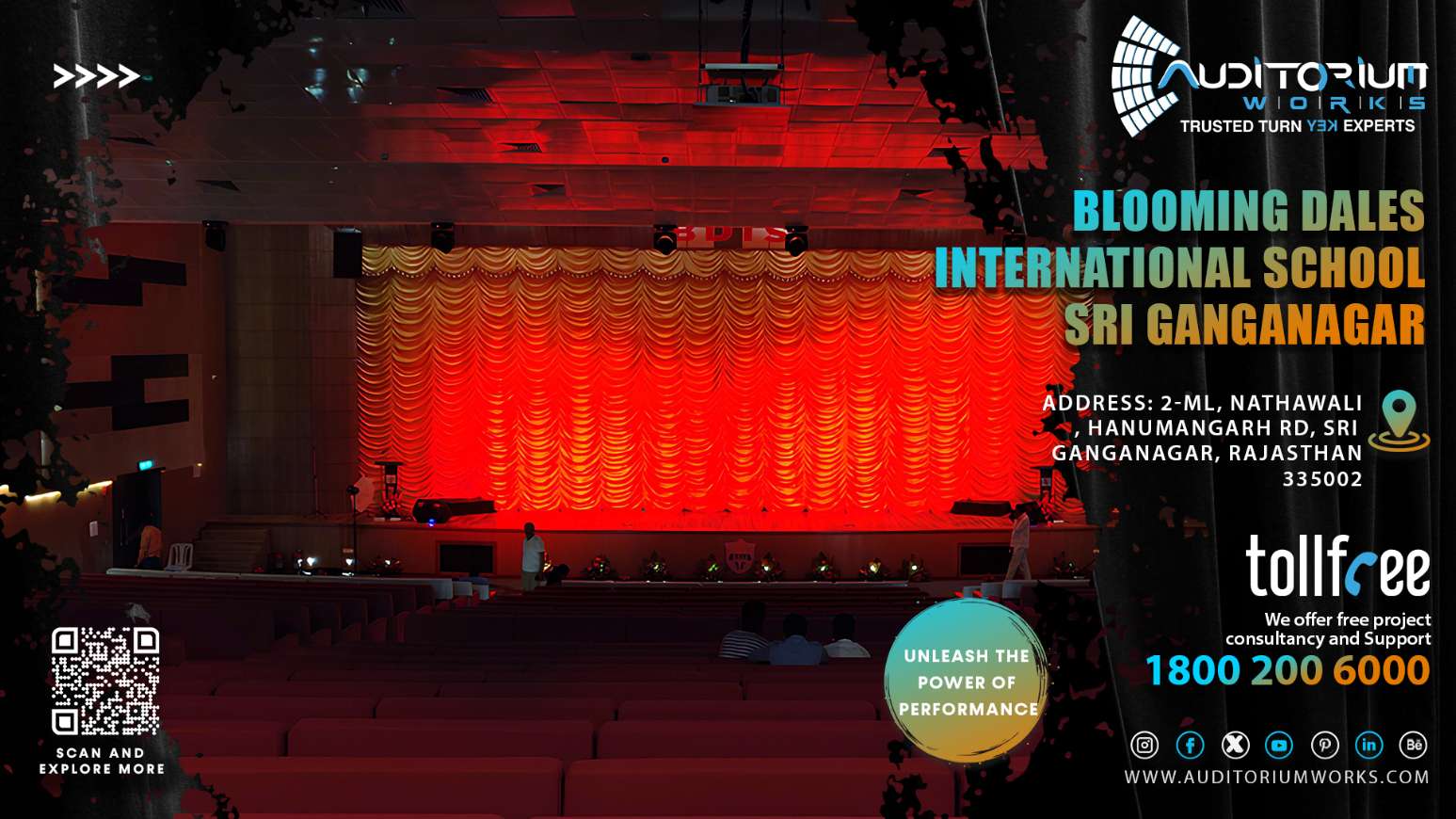“`html
Understanding the Soundscape: Why Auditorium Acoustics Matter
An auditorium is more than just a room; it’s a carefully designed space intended to host performances, lectures, presentations, and a myriad of other events. The success of these events hinges, in no small part, on the quality of the sound within the auditorium. Poor acoustics can lead to muffled speech, indistinct music, and an overall unpleasant listening experience. Investing in proper acoustic treatment transforms a potentially problematic space into an acoustically optimized environment where every sound is clear, impactful, and enjoyable.
Key Acoustic Challenges in Auditorium Design
Before delving into treatment solutions, it’s crucial to understand the common acoustic challenges faced in auditorium spaces. These challenges often stem from the room’s size, shape, and the materials used in its construction.
Reverberation: The Lingering Sound
Reverberation is the persistence of sound after the original sound source has stopped. Excessive reverberation blurs speech intelligibility and muddies musical performances. The ideal reverberation time varies depending on the auditorium’s intended use. A lecture hall, for example, requires a shorter reverberation time than a concert hall.
Echoes: Distinct and Distracting
Unlike reverberation, echoes are distinct repetitions of the original sound. They occur when sound waves bounce off hard, reflective surfaces and reach the listener with a noticeable delay. Echoes are highly distracting and can severely impair the listening experience.
Sound Focusing: Hot Spots and Dead Zones
Concave surfaces can focus sound waves into specific areas, creating “hot spots” where the sound is excessively loud. Conversely, other areas may experience “dead zones” with significantly reduced sound levels. Uneven sound distribution disrupts the audience’s ability to hear clearly.
Flutter Echo: A Rapid Succession of Echoes
Flutter echo is a rapid succession of echoes occurring between parallel, hard surfaces. This creates a “fluttering” or “buzzing” sound that is particularly noticeable with percussive sounds.
External Noise Intrusion: Keeping the Outside Out
External noise from traffic, HVAC systems, or nearby activities can penetrate the auditorium, masking the intended sound and distracting the audience. Effective acoustic treatment also addresses sound isolation to minimize noise intrusion.
The Arsenal of Acoustic Treatment Solutions
Addressing these acoustic challenges requires a combination of strategically placed acoustic treatment materials. The goal is to control reverberation, eliminate echoes, diffuse sound, and block external noise.
Sound Absorbers: Taming Reverberation
Sound absorbers are materials designed to absorb sound energy, reducing reverberation and improving clarity. Common types of sound absorbers include:
- Acoustic Panels: Fabric-wrapped panels that effectively absorb sound across a wide frequency range. They can be mounted on walls or ceilings and are available in various sizes, shapes, and colors.
- Acoustic Baffles: Suspended vertically from the ceiling, baffles are excellent for absorbing sound in large, open spaces. They are particularly effective in reducing reverberation in auditoriums with high ceilings.
- Acoustic Clouds: Suspended horizontally from the ceiling, clouds provide sound absorption without covering the entire ceiling surface. They can be strategically placed to target specific areas of high reflection.
- Bass Traps: Designed to absorb low-frequency sound waves, bass traps are crucial for controlling boominess and improving bass clarity. They are typically placed in corners or along walls.
Sound Diffusers: Scattering Sound Energy
Sound diffusers scatter sound waves in multiple directions, preventing echoes and creating a more even sound distribution. Unlike absorbers, diffusers do not significantly reduce reverberation. Common types of sound diffusers include:
- Quadratic Residue Diffusers (QRDs): These diffusers use a series of wells with varying depths to scatter sound waves. They are highly effective at diffusing sound across a broad frequency range.
- Primitive Root Diffusers: Similar to QRDs, primitive root diffusers use a different mathematical sequence to determine the well depths.
- Poly Cylindrical Diffusers (Polyfusors): Curved surfaces that scatter sound waves in multiple directions. They are particularly effective at diffusing mid-range frequencies.
Sound Barriers: Blocking Noise Transmission
Sound barriers are materials designed to block sound transmission, preventing noise from entering or leaving the auditorium. Common types of sound barriers include:
- Mass-Loaded Vinyl (MLV): A dense, flexible material that effectively blocks sound transmission. It is often used in walls, ceilings, and floors.
- Acoustic Doors and Windows: Specially designed doors and windows with airtight seals and heavy construction to minimize sound leakage.
- Double Wall Construction: Constructing walls with two separate layers, separated by an air gap and sound-dampening materials, significantly reduces sound transmission.
Strategic Placement: Maximizing Acoustic Effectiveness
The effectiveness of acoustic treatment depends not only on the materials used but also on their strategic placement. A qualified acoustic consultant can perform detailed acoustic modeling to determine the optimal placement of absorbers, diffusers, and barriers.
First Reflection Points: Taming Early Reflections
First reflection points are the locations on walls and ceilings where sound waves first reflect from the speakers to the listener. Treating these points with sound absorbers significantly reduces early reflections, improving clarity and imaging.
Corners and Edges: Addressing Bass Frequencies
Corners and edges tend to accumulate low-frequency sound waves. Placing bass traps in these locations effectively absorbs bass frequencies, reducing boominess and improving bass clarity.
Rear Walls: Preventing Echoes
Rear walls are often a major source of echoes. Treating rear walls with sound absorbers or diffusers prevents echoes and improves overall sound quality.
Ceilings: Controlling Reverberation
Ceilings can be treated with acoustic panels, baffles, or clouds to control reverberation and improve speech intelligibility.
The Role of Acoustic Consulting: Ensuring Optimal Results
Achieving optimal acoustics in an auditorium is a complex process that requires specialized knowledge and expertise. An experienced acoustic consultant can assess the room’s acoustic characteristics, identify potential problems, and recommend appropriate treatment solutions.
Acoustic Modeling and Simulation
Acoustic consultants use sophisticated software to model and simulate the sound behavior within the auditorium. This allows them to predict the effectiveness of different treatment solutions and optimize their placement.
Material Selection and Specification
Acoustic consultants can help you select the appropriate acoustic treatment materials based on your specific needs, budget, and aesthetic preferences. They can also provide detailed specifications for installation.
Installation Supervision and Testing
Acoustic consultants can supervise the installation of acoustic treatment materials to ensure that they are installed correctly. They can also perform post-installation testing to verify that the desired acoustic performance has been achieved.
Budget Considerations: Balancing Cost and Performance
The cost of acoustic treatment can vary widely depending on the size of the auditorium, the complexity of the design, and the materials used. It’s important to establish a realistic budget and prioritize the most critical areas for treatment.
Phased Implementation
Acoustic treatment can be implemented in phases, starting with the most critical areas and gradually expanding to other areas as budget allows. This allows you to improve the acoustics of the auditorium over time without breaking the bank.
DIY vs. Professional Installation
Some acoustic treatment materials can be installed by experienced DIYers, while others require professional installation. Consider your skills and experience when deciding whether to tackle the installation yourself or hire a professional.
Conclusion: Transforming Your Auditorium into an Acoustic Masterpiece
Investing in proper acoustic treatment is essential for creating an auditorium that delivers exceptional sound quality. By understanding the key acoustic challenges, utilizing appropriate treatment solutions, and working with a qualified acoustic consultant, you can transform your auditorium into a space where every sound is clear, impactful, and enjoyable, enhancing the overall experience for performers and audiences alike.
“`



